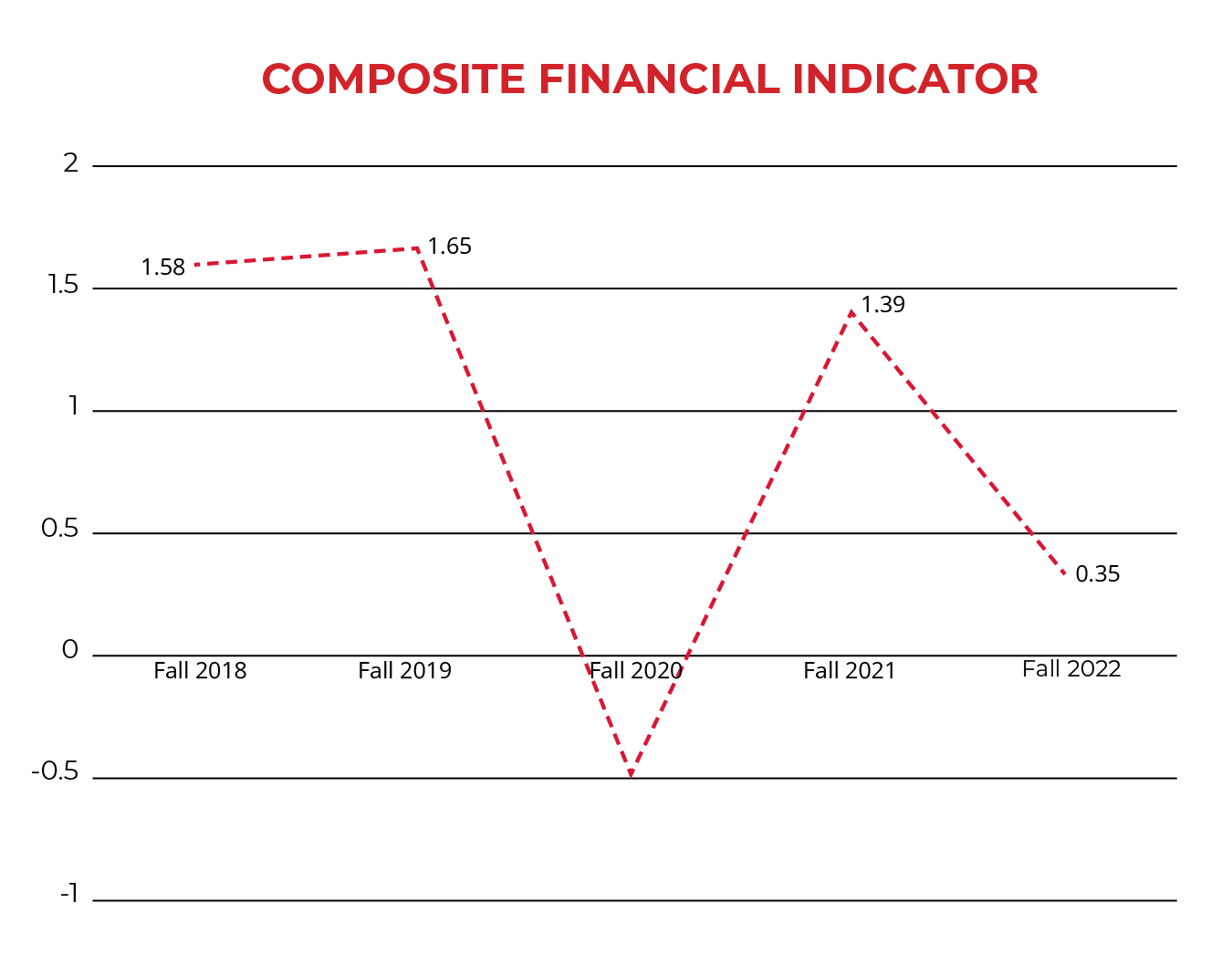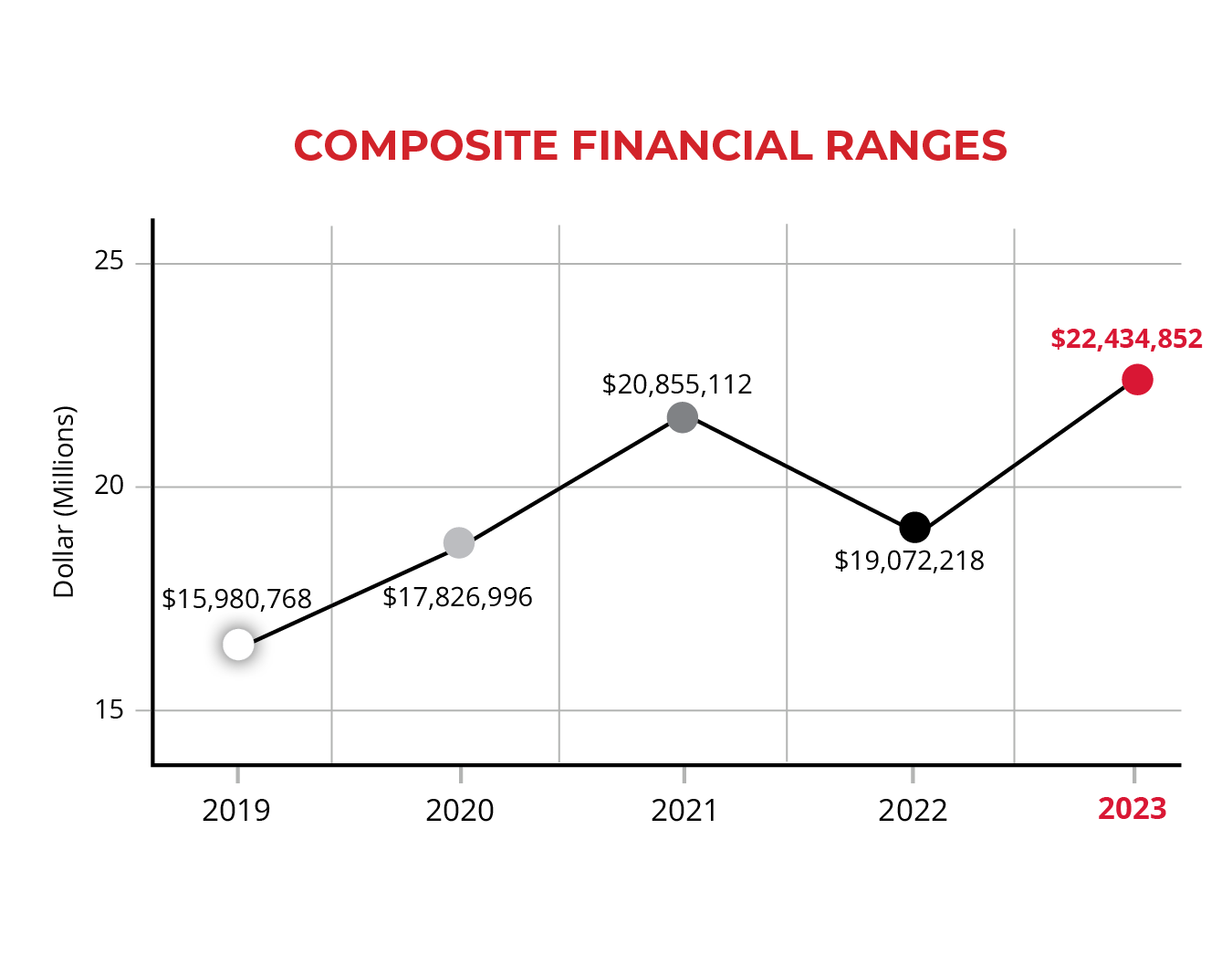Goals, Metrics, & Outcomes
Institutional Sustainability
Institutional sustainability refers to the ability of an educational institution to operate in a manner that meets the needs of the present without compromising future success. It involves a commitment to environmental, social, and economic practices that contribute to long-term viability and resilience.
Goal
Enhance the financial stability and sustainability of the institution through strategic financial planning, responsible resource allocation, and innovative revenue-generation initiatives, ensuring long-term resilience and success.
Goal Monitoring Metrics
Composite Financial Index (CFI) measures the relative financial health of the institution, and is used widely throughout higher education. The CFI includes four commonly used financial ratios: Primary Reserve Ratio; Viability Ratio; Net Operating Revenue Ratio; and Return on Net Assets Ratio.


The following is a summary of CFI ranges and a sense, in general terms, of how the CFI score positions an institution:
-1 to 1 – Assess viability to survive
0 to 3 – Reengineer
3 to 5 – Direct resources to allow transformation
5 to 7 – Focus resources to compete in the future
7 to 9 – Opportunities to experiment with new initiatives
8 to 10 – Deploy resources to achieve a robust mission
Endowment Growth. Endowments are designed to provide a permanent source of income for the university by keeping the original amount invested and using the accrued investment income to fulfill the educational mission effectively. The WOU Foundation endowment has grown due to the generosity of donors through bequests, outright gifts and other planned gifts, as well as investment earnings. Changes in endowment growth have implications for the financial stability, affordability, academic quality, and overall competitiveness of institutions of higher education.
Outcomes
- Western adapts to changes in the higher education landscape and implements strategic responses to emerging trends.
- Streamlined and efficient processes enhance teaching methods, research capabilities, resource allocation, and administrative efficiency.
Student Success
Student success is a comprehensive and multifaceted concept that encompasses various aspects of a student’s educational journey and overall development. It goes beyond traditional measures of academic achievement and includes personal growth, well-being, and readiness for future endeavors. Student success is a dynamic and evolving process that recognizes and celebrates the diverse pathways and aspirations of individuals within the educational community.
Goal
Enhance degree completion rates for undergraduate, graduate, and transfer students, through strategic initiatives focused on academic support, streamlined pathways, and the necessary services that ensure timely and successful attainment of their educational goals.
Goal Monitoring Metrics
Graduation Rates. The graduation rate is a metric used in higher education to measure the proportion of first-time, full-time students and transfer students who complete their degree program within a specified period of time. It reflects the proportion of students who graduate within a standard timeframe, such as four (100%), six (150%), or eight (200%) years for undergraduate programs.
Graduation Rates will be disaggregated by gender, resident, non-resident, under-represented minority, first-generation, and Pell grant status (proxy for socio-economic status).
Outcomes
- Students are supported in a way that fosters satisfaction, belonging, engagement, and empowerment.
- Students complete their educational goals and develop a lifelong learning mindset, preparing them for continuous education and professional development throughout their careers.
Transformational Diversity
Rather than simply looking at numbers and data metrics as the defining measurements for a diverse environment, a belief in transformational diversity demands thoughtful and engaged actions that result in real and meaningful change. Transformational diversity focuses on developing and implementing diverse and inclusive philosophies and practices while evaluating and analyzing the effects on the institution.
Goal
Foster an inclusive educational, living, and work environment at Western Oregon University, ensuring that students and employees feel a profound sense of belonging and have abundant opportunities for growth and success.
Goal Monitoring Metrics
Enrollment, Retention & Persistence (Undergraduate); Enrollment, Retention, & Persistence (UG Transfer); Enrollment (Graduate).
Enrollment: At census for fall term, the number of full- and part-time students, by gender, race/ethnicity, and level (undergraduate and graduate, including doctor’s – professional practice students); the total number of full- and part-time undergraduate degree/certificate-seeking students (first-time entering, transfer-ins, and continuing/returning) and full- and part-time undergraduate non-degree/non-certificate students).
Retention: A measure of the rate at which students persist in their educational program at an institution, expressed as a percentage. Retention refers specifically to the proportion of first time, full-time students retained from their first fall to their second fall. First-time meaning first time in college.
Persistence: The proportion of a first-time, full-time student cohort persisting to their next 3rd, 4th, etc. fall term.
These data will be disaggregated by gender, resident, non-resident, under-represented minority, first-generation, and Pell grant status (proxy for socio-economic status).
Campus Climate Survey. A research instrument designed to assess the attitudes, perceptions, experiences, and behaviors of members of a college or university community regarding the social, cultural, and institutional climate on campus. The survey will be administered to students, faculty, and staff every three years beginning in 2025 to track changes over time and inform institutional efforts to promote a positive and inclusive campus environment.
Employee Retention Rate. The percentage of employees who remain employed at an institution over a specific period measured annually and disaggregated by employee category (tenure-track, non-tenure track, classified, and unclassified) as well as by gender and race/ethnicity. It is a key metric used to assess the effectiveness of an institution’s efforts to retain its faculty, staff, and administrators. A high employee retention rate indicates that the institution is successful in retaining its workforce.
Outcomes
- The overall quality and richness of the Western community is enhanced by diverse and talented students and employees.
- Western establishes positive, collaborative, and accessible learning and working environments that promote creativity, innovation, and effective teamwork.
Community Strength
A university is built around a variety of communities. Classrooms, departments, units, divisions, teams, interdepartmental work groups, etc. are made up of individuals who must navigate multiple voices and perspectives. Strengthening the ways that communities interact, paying close attention to accessibility, collaboration, and communication allows employees and students alike to grow in positive ways.
Goal
Cultivate and maintain a culture at Western Oregon University that embraces collaboration, connection, and communication as we build meaningful partnerships with internal and external communities, while enriching the educational experience of our students.
Goal Monitoring Metrics
NSSE High Impact Practices & NSSE Engagement Indicators. NSSE stands for the National Survey of Student Engagement. It is a widely used survey instrument administered by the Indiana University Center for Postsecondary Research. NSSE is designed to assess the extent to which undergraduate students engage in educational practices associated with high levels of learning and personal development.
Due to their positive associations with student learning and retention, certain undergraduate opportunities are designated “high-impact.” High-Impact Practices (HIPs) share several traits: They demand considerable time and effort, facilitate learning outside of the classroom, require meaningful interactions with faculty and students, encourage collaboration with diverse others, and provide frequent and substantive feedback.
Student engagement represents two critical features of collegiate quality. The first is the amount of time and effort students put into their studies and other educationally purposeful activities. The second is how institutional resources, courses, and other learning opportunities facilitate student participation in activities that matter to student learning.
Campus Climate Survey. A research instrument designed to assess the attitudes, perceptions, experiences, and behaviors of members of a college or university community regarding the social, cultural, and institutional climate on campus. The survey will be administered to students, faculty, and staff every three years beginning in 2025 to track changes over time and inform institutional efforts to promote a positive and inclusive campus environment.
Outcomes
- Students feel connected to a larger community and see the real-world relevance of their academic pursuits.
- The Western Oregon University community and community partners work with a sense of shared interest and mutual benefit, navigating external factors, such as economic shifts, policy changes, and global events, with a proactive and adaptive approach.

